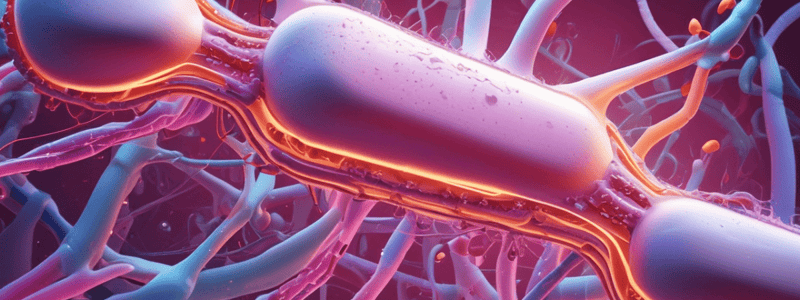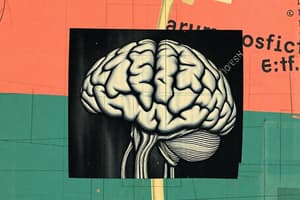Podcast
Questions and Answers
How do local anesthetics reduce excitability of neuronal, cardiac, or central nervous system tissue?
How do local anesthetics reduce excitability of neuronal, cardiac, or central nervous system tissue?
- By blocking Na1 current through voltage-gated channels (correct)
- By altering the resting transmembrane potential
- By enhancing the transmission of nerve impulses
- By increasing the rate of depolarization
Which part of the sodium channel serves as a specific receptor for local anesthetic molecules?
Which part of the sodium channel serves as a specific receptor for local anesthetic molecules?
- b subunit
- a subunit (correct)
- DI subunit
- DII subunit
What happens when sodium ion channel permeability fails to increase?
What happens when sodium ion channel permeability fails to increase?
- An action potential is propagated
- The rate of depolarization speeds up
- Threshold potential is not reached (correct)
- Threshold potential is reached more quickly
How do local anesthetics affect the transmission of nerve impulses?
How do local anesthetics affect the transmission of nerve impulses?
What is the role of the b subunits in the sodium channel?
What is the role of the b subunits in the sodium channel?
How many distinct functional subtypes of voltage-gated Na1 channels are recognized based on their pore-forming a subunits?
How many distinct functional subtypes of voltage-gated Na1 channels are recognized based on their pore-forming a subunits?
Which subunit of the sodium ion channel allows for ion conduction and binds to local anesthetics?
Which subunit of the sodium ion channel allows for ion conduction and binds to local anesthetics?
How do the binding affinities of local anesthetics to sodium ion channels depend?
How do the binding affinities of local anesthetics to sodium ion channels depend?
Which state of the sodium channel do local anesthetics preferentially bind to?
Which state of the sodium channel do local anesthetics preferentially bind to?
What is the mechanism by which local anesthetics prevent the conduction of nerve impulses?
What is the mechanism by which local anesthetics prevent the conduction of nerve impulses?
How do local anesthetics gain access to their receptors on sodium channels?
How do local anesthetics gain access to their receptors on sodium channels?
What is the relationship between the frequency of nerve stimulation and the conduction blockade induced by local anesthetics?
What is the relationship between the frequency of nerve stimulation and the conduction blockade induced by local anesthetics?
Which type of ion channel, in addition to sodium channels, are also blocked by local anesthetics?
Which type of ion channel, in addition to sodium channels, are also blocked by local anesthetics?
What is the term used to describe the minimum concentration of a local anesthetic required to produce conduction blockade of nerve impulses?
What is the term used to describe the minimum concentration of a local anesthetic required to produce conduction blockade of nerve impulses?
How does an increased tissue pH affect the Cm (minimum concentration) of a local anesthetic?
How does an increased tissue pH affect the Cm (minimum concentration) of a local anesthetic?
How does nerve fiber diameter affect the Cm (minimum concentration) of a local anesthetic?
How does nerve fiber diameter affect the Cm (minimum concentration) of a local anesthetic?
Which factor is MOST important in the redistribution of local anesthetics after rapid initial uptake into the lungs?
Which factor is MOST important in the redistribution of local anesthetics after rapid initial uptake into the lungs?
Which of the following patient-related factors LEAST influences the absorption and plasma concentrations of local anesthetics?
Which of the following patient-related factors LEAST influences the absorption and plasma concentrations of local anesthetics?
What is the primary mechanism by which the lungs limit the concentration of local anesthetics that reach the systemic circulation?
What is the primary mechanism by which the lungs limit the concentration of local anesthetics that reach the systemic circulation?
Which of the following is the MAIN reason that clearance values and elimination half-times for amide local anesthetics represent mainly hepatic metabolism?
Which of the following is the MAIN reason that clearance values and elimination half-times for amide local anesthetics represent mainly hepatic metabolism?
Which of the following is the LEAST important step in the complete metabolism of amide local anesthetics?
Which of the following is the LEAST important step in the complete metabolism of amide local anesthetics?
Which of the following is the MAIN reason that sustained increases in plasma concentrations and systemic toxicity are more likely with amide local anesthetics compared to ester local anesthetics?
Which of the following is the MAIN reason that sustained increases in plasma concentrations and systemic toxicity are more likely with amide local anesthetics compared to ester local anesthetics?
Which of the following is the LEAST likely way that propranolol can influence the pharmacokinetics of local anesthetics?
Which of the following is the LEAST likely way that propranolol can influence the pharmacokinetics of local anesthetics?
Which of the following is the MAIN reason that pharmacokinetic studies of ester local anesthetics are limited?
Which of the following is the MAIN reason that pharmacokinetic studies of ester local anesthetics are limited?
Which of the following amide local anesthetics undergoes the SLOWEST metabolism?
Which of the following amide local anesthetics undergoes the SLOWEST metabolism?
What is the MAIN reason that renal excretion of unchanged local anesthetics is usually less than 5%?
What is the MAIN reason that renal excretion of unchanged local anesthetics is usually less than 5%?
What is the purpose of adding 1 mL of 8.4% sodium bicarbonate to 30 mL of chloroprocaine solution before placing it into the epidural space?
What is the purpose of adding 1 mL of 8.4% sodium bicarbonate to 30 mL of chloroprocaine solution before placing it into the epidural space?
What is the primary reason for adding epinephrine to a local anesthetic solution?
What is the primary reason for adding epinephrine to a local anesthetic solution?
What is the effect of adding epinephrine to bupivacaine or etidocaine solutions compared to adding it to lidocaine solutions?
What is the effect of adding epinephrine to bupivacaine or etidocaine solutions compared to adding it to lidocaine solutions?
What is the effect of adding epinephrine to a low dose of tetracaine (6 mg) for spinal anesthesia?
What is the effect of adding epinephrine to a low dose of tetracaine (6 mg) for spinal anesthesia?
What is the effect of adding epinephrine to local anesthetic solutions on the onset rate of local anesthesia?
What is the effect of adding epinephrine to local anesthetic solutions on the onset rate of local anesthesia?
What is the effect of adding epinephrine to local anesthetic solutions on the likelihood of systemic toxicity?
What is the effect of adding epinephrine to local anesthetic solutions on the likelihood of systemic toxicity?
What is the potential adverse effect of administering local anesthetic solutions containing epinephrine in the presence of inhaled anesthetics?
What is the potential adverse effect of administering local anesthetic solutions containing epinephrine in the presence of inhaled anesthetics?
What are the two principal side effects related to the use of local anesthetics?
What are the two principal side effects related to the use of local anesthetics?
What is the impact of adding epinephrine to the local anesthetic solution influenced by?
What is the impact of adding epinephrine to the local anesthetic solution influenced by?
What is the effect of adding epinephrine or phenylephrine to bupivacaine or lidocaine placed into the subarachnoid space?
What is the effect of adding epinephrine or phenylephrine to bupivacaine or lidocaine placed into the subarachnoid space?
What is the estimated rate of systemic toxicity resulting in seizures with the use of local anesthetics?
What is the estimated rate of systemic toxicity resulting in seizures with the use of local anesthetics?
Which local anesthetic is the drug most likely to be associated with systemic toxicity resulting in seizures?
Which local anesthetic is the drug most likely to be associated with systemic toxicity resulting in seizures?
What percentage of adverse reactions to local anesthetics are due to an allergic mechanism?
What percentage of adverse reactions to local anesthetics are due to an allergic mechanism?
Which class of local anesthetics is more likely to evoke an allergic reaction?
Which class of local anesthetics is more likely to evoke an allergic reaction?
What is the primary cause of reactions that are often attributed to an allergic reaction to local anesthetics?
What is the primary cause of reactions that are often attributed to an allergic reaction to local anesthetics?
What is the basis for cross-sensitivity between different classes of local anesthetics?
What is the basis for cross-sensitivity between different classes of local anesthetics?
Which local anesthetic has the highest rate of hydrolysis by plasma cholinesterase?
Which local anesthetic has the highest rate of hydrolysis by plasma cholinesterase?
Which local anesthetic is the most slowly eliminated of all the amide derivatives?
Which local anesthetic is the most slowly eliminated of all the amide derivatives?
Which local anesthetic is metabolized in the liver and is highly bound to a1-acid glycoprotein?
Which local anesthetic is metabolized in the liver and is highly bound to a1-acid glycoprotein?
Which enzyme is inhibited by dibucaine, leading to prolonged effects and toxicity of certain drugs?
Which enzyme is inhibited by dibucaine, leading to prolonged effects and toxicity of certain drugs?
Which local anesthetic has its metabolism facilitated by measurement of the degree of enzyme suppression by dibucaine?
Which local anesthetic has its metabolism facilitated by measurement of the degree of enzyme suppression by dibucaine?
Which local anesthetic has an elimination half-time shorter than bupivacaine?
Which local anesthetic has an elimination half-time shorter than bupivacaine?
What is the antigen responsible for subsequent allergic reactions to ester local anesthetics?
What is the antigen responsible for subsequent allergic reactions to ester local anesthetics?
Which local anesthetic undergoes hydrolysis in the liver rather than in the plasma?
Which local anesthetic undergoes hydrolysis in the liver rather than in the plasma?
What is a test termed that evaluates patients suspected of having atypical pseudocholinesterase by measuring the degree of enzyme suppression by dibucaine?
What is a test termed that evaluates patients suspected of having atypical pseudocholinesterase by measuring the degree of enzyme suppression by dibucaine?
Which local anesthetic has an intermediate lipid solubility between lidocaine and bupivacaine?
Which local anesthetic has an intermediate lipid solubility between lidocaine and bupivacaine?
What is the advantage of benzocaine being a weak acid (pKa 3.5)?
What is the advantage of benzocaine being a weak acid (pKa 3.5)?
What is a potential life-threatening complication associated with benzocaine?
What is a potential life-threatening complication associated with benzocaine?
How does alkalinization of local anesthetic solutions affect the onset of neural blockade?
How does alkalinization of local anesthetic solutions affect the onset of neural blockade?
Which substance has shown promising results when added to the intrathecal space along with local anesthetic?
Which substance has shown promising results when added to the intrathecal space along with local anesthetic?
What does the combination of local anesthetics using chloroprocaine and bupivacaine aim to achieve?
What does the combination of local anesthetics using chloroprocaine and bupivacaine aim to achieve?
What is a common method used to speed up the onset of peripheral nerve block and epidural block?
What is a common method used to speed up the onset of peripheral nerve block and epidural block?
Why is cocaine present in urine for 24 to 36 hours?
Why is cocaine present in urine for 24 to 36 hours?
What effect does dexmedetomidine have when used as an adjuvant in local anesthetic mixtures?
What effect does dexmedetomidine have when used as an adjuvant in local anesthetic mixtures?
Which of the following statements about lidocaine is correct?
Which of the following statements about lidocaine is correct?
What is the primary concern with the use of prilocaine?
What is the primary concern with the use of prilocaine?
Which of the following statements about mepivacaine is true?
Which of the following statements about mepivacaine is true?
What is the primary metabolite of bupivacaine that has been measured in blood or urine?
What is the primary metabolite of bupivacaine that has been measured in blood or urine?
Which of the following statements about ropivacaine is true?
Which of the following statements about ropivacaine is true?
What is the primary plasma protein-binding site for bupivacaine?
What is the primary plasma protein-binding site for bupivacaine?
Which of the following factors can increase the concentration of $\alpha_1$-acid glycoprotein, the primary plasma protein-binding site for bupivacaine?
Which of the following factors can increase the concentration of $\alpha_1$-acid glycoprotein, the primary plasma protein-binding site for bupivacaine?
Which of the following statements about maternal clearance of lidocaine is true?
Which of the following statements about maternal clearance of lidocaine is true?
What is the primary mechanism by which prilocaine causes methemoglobinemia?
What is the primary mechanism by which prilocaine causes methemoglobinemia?
Which of the following statements about the metabolism of bupivacaine is true?
Which of the following statements about the metabolism of bupivacaine is true?
Which of the following statements about the minimum length of myelinated nerve fiber required for conduction blockade is correct?
Which of the following statements about the minimum length of myelinated nerve fiber required for conduction blockade is correct?
Which of the following statements about the differential conduction blockade of nerve fibers by local anesthetics is correct?
Which of the following statements about the differential conduction blockade of nerve fibers by local anesthetics is correct?
Which statement best describes the effect of pH on the ionization of local anesthetics?
Which statement best describes the effect of pH on the ionization of local anesthetics?
Which of the following factors influences the apparent potency and duration of action of local anesthetics?
Which of the following factors influences the apparent potency and duration of action of local anesthetics?
Which of the following statements best explains why lidocaine has a shorter duration of action compared to mepivacaine?
Which of the following statements best explains why lidocaine has a shorter duration of action compared to mepivacaine?
Which of the following statements best explains the occasional prolonged sensory blockade observed after injection of etidocaine?
Which of the following statements best explains the occasional prolonged sensory blockade observed after injection of etidocaine?
Which of the following statements regarding the absorption of local anesthetics into the systemic circulation is correct?
Which of the following statements regarding the absorption of local anesthetics into the systemic circulation is correct?
Which of the following statements regarding the differential conduction blockade of nerve fibers by local anesthetics is correct?
Which of the following statements regarding the differential conduction blockade of nerve fibers by local anesthetics is correct?
Which of the following statements regarding the effect of tissue infection on local anesthesia is correct?
Which of the following statements regarding the effect of tissue infection on local anesthesia is correct?
What term is used to describe the anesthesia produced by the IV injection of a local anesthetic solution into an extremity isolated from the rest of the systemic circulation by a tourniquet?
What term is used to describe the anesthesia produced by the IV injection of a local anesthetic solution into an extremity isolated from the rest of the systemic circulation by a tourniquet?
Which drug, when used as an additive to local anesthetic solutions for peripheral nerve blocks, is associated with significant adverse effects and therefore cannot be routinely recommended?
Which drug, when used as an additive to local anesthetic solutions for peripheral nerve blocks, is associated with significant adverse effects and therefore cannot be routinely recommended?
What is the determining factor for the duration of anesthesia in IV regional anesthesia where a local anesthetic solution is injected into an extremity isolated by a tourniquet?
What is the determining factor for the duration of anesthesia in IV regional anesthesia where a local anesthetic solution is injected into an extremity isolated by a tourniquet?
Which local anesthetic is most frequently chosen for producing IV regional anesthesia?
Which local anesthetic is most frequently chosen for producing IV regional anesthesia?
Which amide local anesthetic provided superior analgesia compared to lidocaine when utilized for IV regional anesthesia?
Which amide local anesthetic provided superior analgesia compared to lidocaine when utilized for IV regional anesthesia?
What effect does the release of a tourniquet have on normal sensation and skeletal muscle tone in IV regional anesthesia?
What effect does the release of a tourniquet have on normal sensation and skeletal muscle tone in IV regional anesthesia?
Which local anesthetics produce satisfactory effects when used for IV regional anesthesia?
Which local anesthetics produce satisfactory effects when used for IV regional anesthesia?
For IV regional anesthesia, what do lower plasma concentrations of prilocaine compared to lidocaine after tourniquet deflation indicate?
For IV regional anesthesia, what do lower plasma concentrations of prilocaine compared to lidocaine after tourniquet deflation indicate?
What does the duration of anesthesia in IV regional anesthesia depend on?
What does the duration of anesthesia in IV regional anesthesia depend on?
What characteristic distinguishes intravenous regional anesthesia from other types of anesthesia techniques?
What characteristic distinguishes intravenous regional anesthesia from other types of anesthesia techniques?
Flashcards are hidden until you start studying




